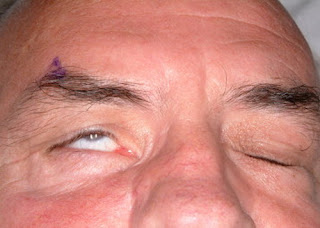What is Lagophthalmos?
Lagophthalmos is a form of facial paralysis affecting the obicularis muscle in the eyelid and is characterized as the inability to fully or completely close the eyelids. This condition usually affects one side of the face only.Constant exposure of the eyelid to the drying effects of the environment due to the inability to completely close the eyelid can lead to ulceration of the cornea or may result to corneal inflammation and scarring.
picture 1: Lagopthalmos affected to obicularis muscle, that cause inability of closing eyelids fully.
image source: els-cdn.com
Blinking mechanism of the eyes constantly bathe it with a thin film of tear. This tear film functions in providing hydration in the eyes while nourishing it. It flushes away dust, debris and other tiny particles that get past the eyelids and lashes protecting the corneal surface against infection. Tear film also maintains a smooth corneal surface to keep the vision clear and undistorted.
Nocturnal lagophthalmos is another condition of inability to completely close the eyes. This condition however, happens at night time or during sleep.
The condition of lagophthalmos can be classified either temporary or permanent. Temporary condition lasts for 6 months or less and can be helped with medical regimen while permanent condition may need surgical intervention.
Patient suffering from lagophthalmos may complain of irritated eyes or the feeling of foreign object inside the eyes. Pain is also noted as a result of constant exposure and dryness of the corneal surface. Blurry vision is also experienced as a result of unstable tear film. Advance cases of lagophthalmos have severe symptoms.
Causes
Lagophthalmos either temporary or permanent can be caused by another condition or trauma to the facial nerves.Facial nerve. This is the 7th cranial nerve that innervates both the frontalis and obicularis muscle. Trauma in any form or other condition involving the facial nerve will inhibit eyelid closure. Such condition and trauma that can lead to lagophthalmos include:
Trauma involving fracture of the bony prominence and skull base can damage the facial nerve. It is also more susceptible to blunt trauma and laceration.

Picture 2: Facial expressions of Lagopthalmos affected person
image source: .pinimg.com
Bell’s Palsy is an idiopathic facial nerve palsy associated with acute viral infection and is also associated with reactivation of herpes simplex virus.Tumors typically of the acoustic neuromas in the cerebellopontine angle and metastatic lesions are commonly associated with lagophthalmos.
Orbicularis muscle. Upper and lower eyelids are made up of several structural layers. Damage to any of these structural layers can inhibit eyelid closure.
These can eventually cause or may cause lagophthalmos and these factors include:
Eyelid surgery that results to excessive removal of eyelid skin and muscle can lead to lagophthalmos of the upper eyelid and retraction of the lower eyelid.
Floppy eyelid syndrome is the result of severe laxity and flexibility in the superior and inferior tarsal plates.
Enophthalmos is the posterior displacement of the eye that may affect eyelid closure.
Pathophysiology
Malfunction in the facial nerve can give rise to lagophthalmos. Decrease in the orbicularis tone common in comatose patient will most likely result to inability in closing the eyelids.Patient with palsy of the 7th cranial nerve or the facial nerve are highly expected to suffer from lagophthalmos. The facial nerve controls the function of the eyelids that paralysis of which inhibits the good closure of the upper and lower eyelids.
The condition of lagophthalmos is not serious although the inability to close the eyelids greatly affects the distribution of tear film necessary in maintaining proper eye health and lubrication. Blinking mechanism can no longer function when the eyelids are paralyzed thereby exposing the eye to environmental elements causing it to dry and prone to dust and other debris infection. Exposure and prolonged dehydration of the eye can result to irritation and pain including blurry vision and other vision problem including blindness.
Surgery
Treating lagophthalmos is geared in preventing further complication as a result of prolonged exposure to drying effects and particles settling in the eye. The goal of treatment is also aimed in resolving the ability of the upper and lower eyelids to close.Temporary condition of lagophthalmos requires medical treatment through administration of nonprserved artificial tears to maintain tear film. Other therapeutic regimen includes application of eye ointment for certain cases of corneal exposures.
Permanent condition of lagophthalmos or longer than anticipated will require surgical intervention or surgical implantation.
Gold weight implantation can be done in the upper eyelid of paralytic lagophthalmos. The procedure involves closure of the upper eyelid in gravity dependent fashion.
Upper eyelid retraction is indicated for patient with lagophthalmos associated with upper eyelid retraction from thyroid opthalmopathy.
Lower eyelid tightening is indicated for lagophthalmos related to floppy eyelid syndrome or facial paralysis. Tightening procedure will improve apposition of the lower eyelid to the globe reducing tearing.
Ancillary surgical procedure is recommended for sever lagophthalmos related to facial nerve palsy. A variety of materials can be used to achieve elevation of the midface such as autogenous fascia slings.

